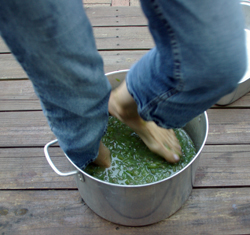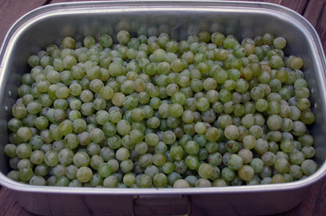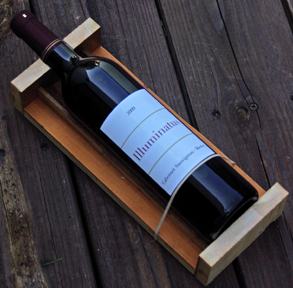|
|
Perhaps it was because the Petite Sirah juice was beginning to ferment or some other reason, however, when I added just the beginning of the 2.5 pounds of sugar to the Petite Sirah juice there was an immediate reaction. The juice was filled to almost the top of the six-gallon container. As soon as the sugar hit the juice it began to foam. It quickly resembled Act 1 Scene 1 from Shakespeare’s MacBeth, however the foam was pink. Quickly spilling over onto the floor, Kathy sprang to action finding maroon bath towels. At the same instant, I stopped pouring sugar into the juice and began transferring a quart at a time to an empty fermentation bin. After several long moments, the juice settled down and stopped foaming.
I added about two gallons of juice to the fermentation bin and then added the rest of the sugar. It didn’t foam nearly as much. After adding the sugar and there was no more foam, I added the remainder of the juice and stirred the mixture. It had settled down and by now we had the floor cleaned up. The juice in the fermentation bin measured to the six-gallon mark, so we didn’t lose very much during the foaming episode. Originally the juice measured 19 brix with a specific gravity of 1.074. After adding the sugar the brix measured 22.5 and the specific gravity was 1.090.
In the future, if I have to chapalize, I’ll add a couple of gallons of juice to the fermentation bin, then add the sugar. I can then add the rest of the juice.
Cheers,
Terry
Two years ago I made my first wine from a kit. I religiously followed the directions often reading them several times before following. If I knew then what I know now, I wouldn’t follow the wine kit’s directions. Last week this started me thinking that since I had empty carboys perhaps I should fill them. Could I make a better wine than I did two years ago without following the directions in the kit?
Kathy interceded however and said that S&S Winegrapes and Equipment Co., in Baltimore, was open and had six-gallon containers of juice. Rather than buying a kit, she wanted to buy juice and make wine from the 100% juice. The juice was sourced from a company in Lodi, California. We decided on a six-gallon drum of Petite Sirah and a six-gallon drum of Muscat. Kathy is going to make the Muscat and I am going to make the Petite Sirah. At S&S, the juice and grapes were kept in refrigerated rooms. By the time we arrived home and opened the containers, the juices had warmed to 53º F. We decided to let them sit overnight to rise to room temperature before adding the yeast.
I took some measurements the following morning. The juices had warmed to 69º F and there was some fermentation going on. Previously, Kathy added some peptic enzyme to the Muscat to help prevent a hazy wine. I didn’t like the sugar levels of the Petite Sirah measuring 19 brix. I added some sugar and measured the brix level at 22.5. To the Petite Sirah I added Premier Cuvée yeast. Not what I wanted to add but it was what I had. Kathy added D-47 to the Muscat. Both fermentation containers were happily fermenting the juice later during the day.
Cheers,
Terry
This post is rather late. We didn’t get much juice out of feet pressing the grapes. It looks like I’ll need to purchase a small wine press for future harvests. We ended up with about three quarts of juice. I add some Lalvin D47 yeast. The yeast is suppose to be low foaming, however on the second day of fermentation there was foam coming out of the airlock. The juice fermented vigorously and quickly. A week later, we racked the now wine to a clear one-gallon jug.
After placing an airlock on the jug, I decided to place the jug in the refrigerator. Since we were traveling, refrigeration seemed to make sense. A few weeks later, the wine is still in the refrigerator. It is clearing up quite well. The wine is going to be a low alcohol wine about 10% alcohol.
Since this is the first wine made from grapes we grew, I think I’ll add a bit of sugar to it and serve it during the holidays as a dessert wine.
Cheers,
Terry
 After the Niagara harvest we sorted the grapes and weighed them. Having almost 13 pounds we had to decide to make jelly or wine. We decided to make a very small batch of wine from the juice. Since we didn’t have a press we were uncertain of how many liters of juice we could press. To get the juice we went with the old-world technology of stomping the grapes. Since Kathy is lighter, she was drafted to do the gentle stomping. After the Niagara harvest we sorted the grapes and weighed them. Having almost 13 pounds we had to decide to make jelly or wine. We decided to make a very small batch of wine from the juice. Since we didn’t have a press we were uncertain of how many liters of juice we could press. To get the juice we went with the old-world technology of stomping the grapes. Since Kathy is lighter, she was drafted to do the gentle stomping.
Her first comment was that the grapes were cold. They were picked early morning before sunshine illuminated the vines. Kathy then began to stomp the grapes. Although there looked like a lot of juice, it didn’t amount to as much as we hoped for. The pulp and juice were put in cheesecloth and strained. After the day we collected about 2.8 liters of juice.
I added some peptic enzyme to the juice to prevent peptic haze during fermentation. Next year I’ll add it to the crushed grapes since it will also increase juice extraction. Also added to the juice was potassium metabisulfite This too was added to the jucice before adding the yeast. I’ll research the possibility of adding it to the crushed grapes before straining the juice next year.
Cheers,
Terry
I recalled that Bob Biale of the Robert Biale Vineyards in Napa said I was crazy to consider blending Cabernet Sauvignon with Tannat. Other California winemakers had raised eyes when I mentioned my plans a year ago. There were also those who said unenthusiastically to “go for it.” So I recently bottled my experimental wine, a blend of 80% Lake County Cab with 20% Tannat from Virginia.
Last evening at Bucci Ristorante in Grosse Pointe Woods, Michigan the wine was tested. It passed! The wine offered black fruit and spice on the aroma and taste. There were bold tannins that restaurant owner Bucci, his wife Shpresa, my brother Tim as well as Kathy and I liked. The Tannat helped to boost the tannins and offered a slightly darker hue to the wine’s color. Although still in bottle shock, the wine was great. Although it will improve with aging, it will never make it to next year.
After this experiment, I would definitely make a Cab/Tannat blend in the future.
Cheers,
Terry
 I decided, for better or worse to harvest the Niagara grapes. They only reached a brix level of 16 and stalled. The seeds were brown and the flavor was good. Normally, I’d let them hang but since some of the berries were beginning to rot and I don’t have many clusters, I decided to pick them. Kathy and I picked the grapes and then hand sorted. We ended up with 12 ¾ pounds. Not much to make wine, but I’ll give it a try. I decided, for better or worse to harvest the Niagara grapes. They only reached a brix level of 16 and stalled. The seeds were brown and the flavor was good. Normally, I’d let them hang but since some of the berries were beginning to rot and I don’t have many clusters, I decided to pick them. Kathy and I picked the grapes and then hand sorted. We ended up with 12 ¾ pounds. Not much to make wine, but I’ll give it a try.
Many people do not like wines made from American grapes. My family is different. When my adult children smell the Niagara grape or wine their immediate comment is, “Grand Ma’s house!” This is in reference to our summer trips to Marcellus, New York. Mom Linck had some Niagara grapes and the kids would help themselves. American varieties have a tendency to evoke memories. While tasting our Cab at Vint Hill Craft Winery last week, the winemaker tasted one of my Niagara grapes. DJ said it reminded him of his Grandfather’s grapes. He never knew what they were called, but remembered their aroma and taste. Varietal American grapes evoke instant memories.
Naming a wine is always interesting and occasionally a fun exercise. Since I’ll only end up with a few bottles, perhaps I’ll call the 2009 vintage Niagara, “Grandma’s House.”
Do Niagara grapes or wine evoke any memories for you?
Cheers,
Terry
Kathy and I traveled to Vint Hill Craft Winery in Virginia to taste our Cabernet Sauvignon in the barrel. Our Cab has been in French oak for nine months, since last November. I can keep it in the barrel until next summer. DJ (Vint Hill’s winemaker) explained that the longer a wine remains in a barrel the less oak influence will be on the aroma and taste. He went on to say that a mistake that some winemakers make is to oak their wines and taste them early on. Often they think the wines are over oaked and rack them out of the barrel. Instead they should have left them in the barrel.
Our Cab had a red to purple color and dark fruit aroma. Blackberries were on the taste. There were plenty of sharp tannins on the finish and Kathy pointed out that she needed food to go with the wine. DJ explained that by leaving the wine in the barrel for another year, the harsh tannins would soften. We should have a Cab that will pair well with food, and can also be easily enjoyed without food.
Cheers,
Terry
 I decided to design a very simple bottle label. Since 2009 was the first vintage of making wines from grapes. To say that we were enlightened at making wine in two different wineries in two states is an understatement. The only thing that was the same at both wineries was the varietal name. However the Cabs were sourced from different California AVA’s. Because of this enlightenment, I chose “Illuminatus” as the 2009 line of wines. I decided to design a very simple bottle label. Since 2009 was the first vintage of making wines from grapes. To say that we were enlightened at making wine in two different wineries in two states is an understatement. The only thing that was the same at both wineries was the varietal name. However the Cabs were sourced from different California AVA’s. Because of this enlightenment, I chose “Illuminatus” as the 2009 line of wines.
Simplicity ruled and since the wine was predominantly Cabernet Sauvignon, I used a French font. I’m pleased with the way the labels turned out. The wine made at Tin Lizzie Wineworks is only for personal consumption, they had the front label printed. I was going to create and print a back label, and then changed my mind. Instead, I’ll just create a web page for the back label, and create a QR code. I can print the QR code on small labels and affix it to the back of a bottle.
Since we had to affix all the labels by hand, I built a simple bottle holder out of wood. The bottle can be placed in the bottle holder and label attached. While in the holder, the bottle won’t move. I’ve seen similar bottle holders at a few boutique wineries we’ve visited. When labeling by hand, a bottle holder is great.
Cheers,
Terry
I’ve been collecting bottles for the past few months. After finishing the wine, the bottles are rinsed and then placed in a wine rack. However I am paranoid about cleaning the wine bottles. After retrieving the bottles from the wine cellar, I placed them in the dishwasher and ran the SaniWash cycle. I did not use dishwashing detergent. Then I shot a solution of potassium metabisulphite into the bottles using the Avvinatore bottle rinser and sulifter (Is that a word?). Then the bottles were placed on a bottle tree. Much easier than what I formally did by pouring the potassium metabisulphite into a bottle, then from one bottle to another and so forth. I then placed the bottles on the racks in the dishwasher. Now we have made progress!
We bottled two wines, the Cabernet Sauvignon/Tannat blend and five bottles of Zinfandel that I rescued from a press as we were breaking it down and cleaning it. I was going to use the pomace for wine jelly but I ended up with a gallon of wine after filtering it through tripled layered cheesecloth. I thought that a gallon would make too much jelly so I placed it in a gallon carboy. I added a French oak spiral and let it sit and age for a couple weeks. After that I removed the spiral and let the wine do its thing in a gallon carboy for nine months.
It took Kathy and me about two hours cleaning and sanitizing things, bottling 35 bottles and cleaning up. I recalled the first time I bottled wine. It took four of us four hours to bottle 29 bottles. Again on with the progress!
Cheers,
Terry
I’ve given up with my Dornfelder. After an assault from birds, I learned to place netting over the vines and grapes. It helped somewhat. We did have to free a few birds from inside the netting. Then the bees went after the grapes. I guess they are ready for harvest although the highest brix I could get from them was 16. Chalk this year up to learning. I didn’t have enough grapes for wine. Didn’t even have enough for jelly. But they do taste good on the dinner table.
I may have enough Niagara to make a small batch of wine though. They too are struggling with sugar. We have had a lot of rain for the past month with showers coming every two to three days. Now, for the first time since the beginning of July we have no rain in the long range forecast. I’m interested in seeing what will happen to the brix. Ten days ago the brix measured 12 and today it measured 15. The seeds are brown, there seems to be good acid in the grapes. I would be happy if the grapes could make it to 18 brix or higher before the next rains come.
I believe that growing grapes gives one a unique understanding of terroir. One can observe how weather is different year after year and the weather certainly affects the grapes. Timing harvest may be in the same ballpark area year after year, but will always have some variance. Harvest of the Niagara is coming soon.
Cheers,
Terry
|
|





